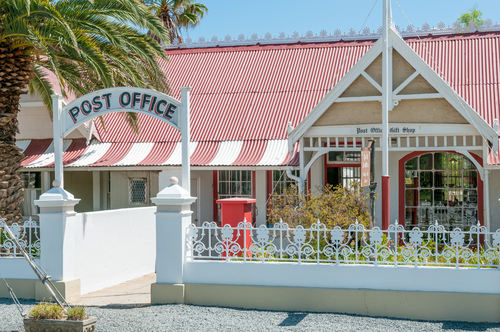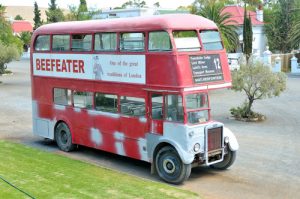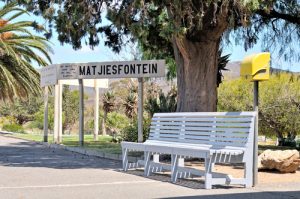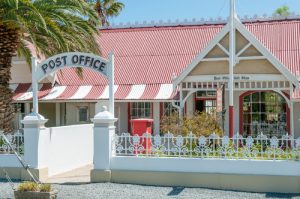Go to 33°13’52.05″S | 20°34’55.77″E on Google Earth and you will see a main road that’s 280m long, with buildings on one side only. Only one other road leads off the main road, and it is all of 150 meters in length.
30 meters from the main road is a railway station, and diagonally across from it is a cricket pitch. Yes, you read it correctly, a cricket pitch.
Two tiny squares of green indicate a garden, and trees line the back of the handful of buildings. If you look closely a splash of blue shows there is a one swimming pool.
The surrounding area is a dirty grey brown with a few hills in the distance.
It looks remote, arid and not terribly enticing at all when viewed on aerial photography.
That’s Matjiesfontein. It is just two streets that calls itself a village, 230km from Cape Town, travelling on the N1.
A little bit of history
So what made the Sultan of Zanzibar, Lord Randolph Churchill (father of Winston) and Cecil John Rhodes visit this remote, dull-looking place. What inspired Olive Schreiner, the well- known author to live here and write the classic “Story of an African Farm”?
The answer is that back in the day, the late 1800’s, it was something of a hipster hangout. James Logan, who founded the town, was a working-class railway man from Scotland with a brilliant business brain, loads of ambition and very keen to be accepted by the upper classes. He imported much of the building materials, furniture and even the lamp posts from London and created a little piece of Victorian England in the middle of the Karoo.
He then marketed it as a place for the genteel to come to relax, recuperate in the dry Karoo air or to hunt and spend a weekend of fine dining and gentlemanly pursuits.
A keen supporter of cricket, James Logan believed that this would function as another way for him to be accepted by the British upper classes, which would be very good for both his ego and his business interests. He laid out the first cricket pitch in the country and invited and funded the first-ever English team to come and play.
Then came the Anglo-Boer war and Matjiesfontein become HQ to the Cape Command. The Coldstream Guards, Middlesex Regiment and Seventeenth Lancers amounted to 1200 soldiers based around the village for the duration of the war.
To read more about James Logan and the fascinating history of Matjiesfontein, get a copy of the recently published and very informative book by Dr. Dean Allen, titled “The Empire, War and Cricket.” It is a riveting account of the life and times of James Logan and Matjiesfontein is central to the story.
So what can you do in “Matjies”?
You can stroll up and down the two streets and marvel at the architecture, décor and evidence of a place where time stopped in another era.
You can heed the call of the bugle to catch the bright red Beefeater Bus for a tour of the town. Johnny the driver will have you in stitches with his irreverent commentary and impromptu singing.
After the tour you can get to know other guests in the Lairds Arms over drinks, while Johnny who drove the bus, puts on his musical hat and belts out a very mixed variety of show tunes on a 100-year-old piano.
If you like you can dress for dinner, but regardless of your attire you will be very well fed every time you enter the dining room.
The Transport Museum, old Standard Bank, Court House and Marie Rawdon Museum are all interesting places that allow you to get lost in time.
If you have space, you can pop in to the Coffee House for a mid-morning snack or browse in the array of gifts and trinkets in the old Post Office.
Ghosts and things that go bump in the night
Accommodation in Matjiesfontein is at the charming Lord Milner Hotel, the only hotel in town. A stay there is not complete without learning something of the hotel’s history, which includes stories of the resident ghost.
Spend some time with the general manager, Johan Dippenaar. He will keep the ghost stories coming all day long. You might be a little skeptical, or you might actually hear the sounds of laughter and the clicking of billiard balls in the wee hours of the morning. Your light might suddenly go off, the door to your room rattled, or you could encounter someone dressed rather strangely in the passages. Who knows what your experience will be with the people from the past.
Ask Johnny to show you the ghost photograph, and then make up your own mind.
Railway lines and the thrill of trains
Check the times with the front desk and stroll over to the railway platform a mere 30m from the entrance to the hotel. There is something rather thrilling about watching the train in the distance, then hearing it, and finally getting the full effect of the noise, smells and the sights of tons and tons of steel rolling into the station. If you are an Instagrammer or photographer, you will know the allure of railway lines, and these ones are easy to walk down onto. The views and crossing lines in both directions are amazing. Getting up before the sunrise is highly recommended as the early morning light is golden and the photo opps on the tracks are excellent. Dress warmly as the Karoo mornings can be bitterly cold.
Just Relax
On the gracious verandah in front of the hotel, in one of the cozy lounges, in the courtyard with the little fountain, next to the pond where the swans preen, in the gardens surrounded by trees or next to the pool with views of the mountains and a typical Karoo wind pump. Take a book, a drink, a partner for conversation, or a hat to shade your face as you doze. The air is fresh and clean and Matjiesfontein was made for relaxing.
Explore the gardens filled with succulents and indigenous shrubs, read the sweet messages in the pet cemetery, walk to the soldier’s grave or amble around the cricket pitch.
The intangibles
Like so many small places that I have encountered in South Africa, Matjiesfontein has uniqueness, a something special that you can’t touch, see or hear. It is an emotional reaction, a sense, a subtle ethos that you will not find in any other place.
For me it is the slowness of time, it is the willingness in the service, not slick at all, but each request is met with kindness, there is a very real human connection.
It is the light, the drama of the weather and the dominance of nature. It is the history and stories that are embedded in every room, each piece of furniture, and every piece of ground you step on. It is a sense that you are in a place where people matter, history matters, you matter.
Go to Matjies, and tell me how you feel.






